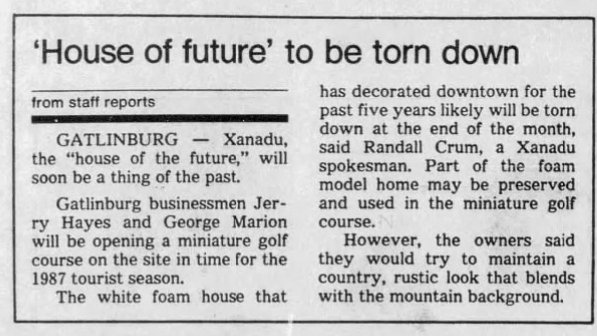Gatlinburg's 'futurific' Xanadu House wowed tourists and enraged locals. Now it's long gone
In the early 1980s, Gatlinburg's Xanadu House stood as an ode to progress and innovation - or to a lack of good taste, depending on your point of view. The attraction was demolished within five years, but memories of the lost East Tennessee artifact remain.
Those who had the chance to visit might recall the home's "Float to Relax" sensory tank, "futurific amenities" and computer room, as described in a Xanadu House brochure. They would almost certainly remember its stark white exterior and strange domed protrusions.
When it first opened in the heart of downtown Gatlinburg, people were entranced by the dazzling possibilities of what the next millennium might hold, while others detested "'that thing on the Parkway,'" as one critic called Xanadu in a 1982 Knoxville News Sentinel article.
What did the Gatlinburg Xanadu House look like?
Xanadu houses in Gatlinburg and elsewhere were constructed with polyurethane foam, which was sprayed over large balloons. The balloons were then removed, and openings for doors and windows were carved out, according to a 1980 article from The Times Colonist in Canada.
In Gatlinburg's Xanadu, tour groups gathered in the main room, a huge space with a tree made of foam and a reflection pond. The room also had a fountain that could become a fireplace, former tour guide Randall Crum recently told Knox News.
Crum's favorite room was the "sight and sound room," designed with acoustics in mind.
“They had this really cool sound system," he said. "Everything was stars above. … The lights would go down, and the music would come on. The guests would be like, 'Wow, wow,'" he said.
A video shot in July 1986 - the last season the attraction was open - shows additional features such as an indoor slide, an early induction stove and an all-in-one washer/dryer. Much of the technology was created by German company Gaggenau Hausger?te, Crum said.
More unreal estate: This midcentury modern house might be the next best thing to living in the Sunsphere
How did a Xanadu House end up in East Tennessee?
The history of the Xanadu House starts in 1979 in Wisconsin Dells, Wisconsin, where the first such attraction was built. The project was led by Bob Masters, who lived in his own polyurethane home and realized the local curiosity his house had generated could be an entrepreneurial opportunity, The Palm Beach Post reported in 2000.
Due to conflict among the project's creators, the Wisconsin Xanadu House was taken over by partner and co-creator Tom Gussel, while Masters began work on a second Xanadu House in Kissimmee, Florida, in collaboration with architect and futurist Roy Mason.
Mason was fascinated by innovative approaches to architecture, Lane Jennings told Knox News. Jennings co-authored "Xanadu: The Computerized Home of Tomorrow and How It Can Be Yours Today!" with Mason and Robert Evans. Mason helped to incorporate futuristic technology at the Kissimmee attraction, which opened in 1983.
Accounts of who built Gatlinburg's Xanadu House differ. Jennings recalls Mason being involved. Fred Hardwick, who managed Tommy Bartlett's Water Circus in Pigeon Forge ? an attraction that had "a financial interest in Xanadu" in the 1980s ? remembers Gussel as its creator.
The Gatlinburg location is often cited as the last to be built. However, the house actually opened to the public in June 1982, about a year before the one in Kissimmee.
The theme of the 1982 World's Fair in Knoxville was "Energy Turns the World," a concept that produced such lasting city staples as the Sunsphere and Petro's (short for petroleum) Chili & Chips.
Although it was miles away from the fair, Xanadu was built for energy efficiency and had "virtually no electric bill." This fit the World's Fair theme, Crum said, and the number of tourists visiting the Gatlinburg attraction was exceptionally high during the months of the Knoxville expo.
Backlash and removal
"Xanadu's appearance, many residents feel, is a far cry from the 'stately pleasure dome' celebrated in Samuel Taylor Coleridge's poem 'Kubla Khan,'" the News Sentinel reported in June 13, 1982.
The house was indeed named for the Coleridge line, but literary allusions weren't enough to dignify it in the public eye. "A lot of people called it the ugliest place on the strip," Crum recalled.
Less than a month after Gatlinburg's Xanadu opened, a petition to change zoning laws was presented at the Gatlinburg City Commission meeting, calling the house "a blight upon our fair city," the News Sentinel reported June 23, 1982.
In addition to aesthetic complaints, the allure of Xanadu's innovation faded. By 1986, much of its technology had already become publicly available.

"The house of the future became the house of the present," Crum said.
After Xanadu closed, it was slated to be replaced with a miniature golf course. Unlike the house, "the owners said they would try to maintain a country, rustic look that blends with the mountain background," the News Sentinel reported in 1986.
More recently, the former Xanadu site was home to the Sugarland Wedding Chapel near Ober Mountain Tramway Mall on the Parkway. It has since been converted to a parking lot.
Hayden Dunbar is the storyteller reporter. Email [email protected].
Support strong local journalism by subscribing at knoxnews.com/subscribe.
This article originally appeared on Knoxville News Sentinel: Tourists loved Gatlinburg's 'futurific' Xanadu House. Locals hated it